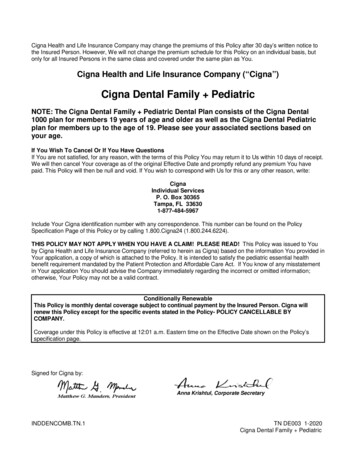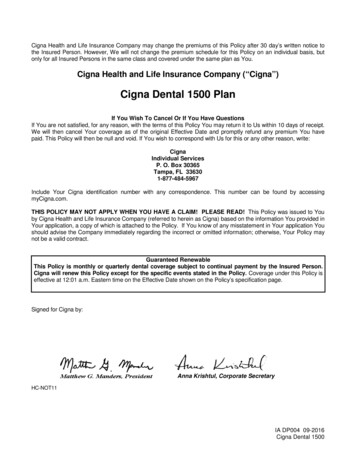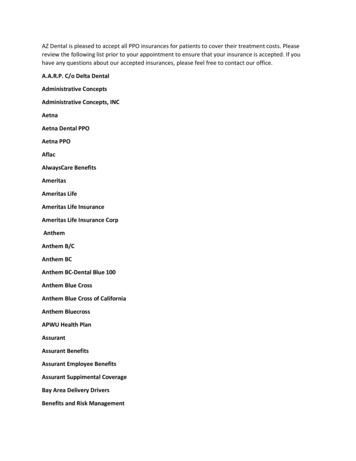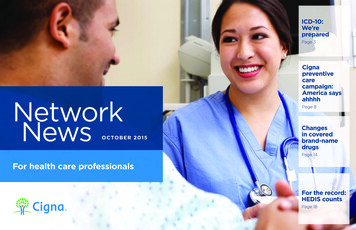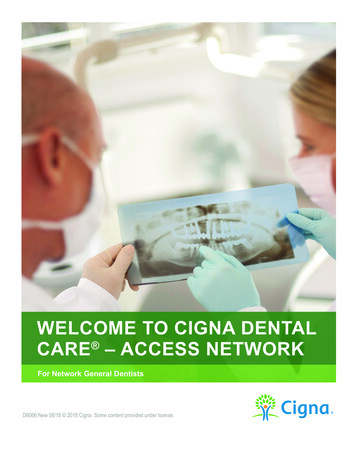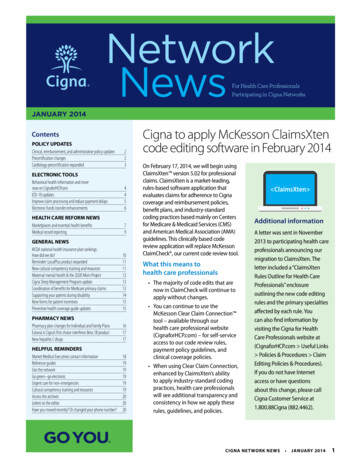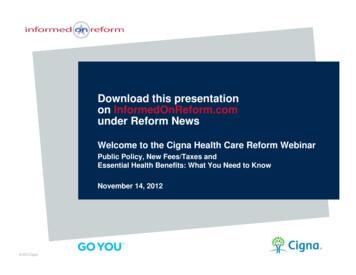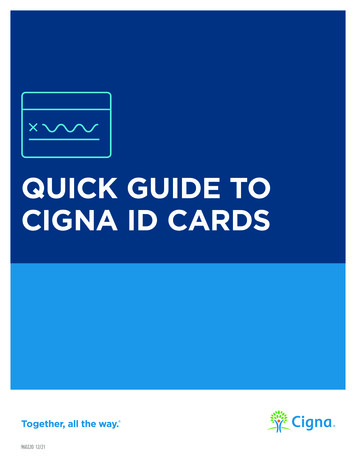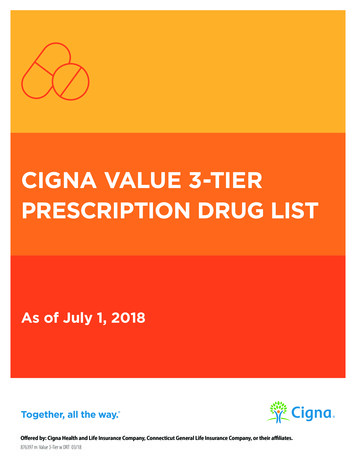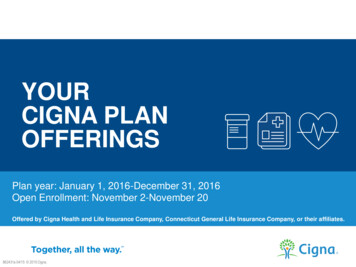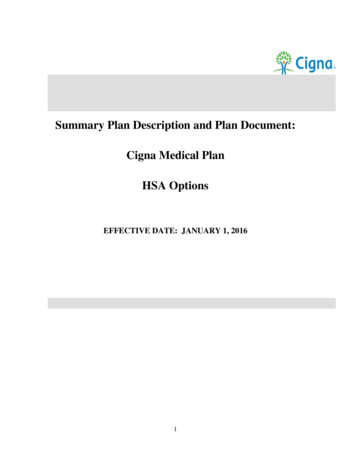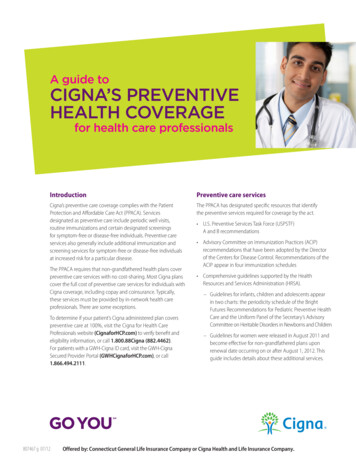
Transcription
A guide toCigna’s PreventiveHealth Coveragefor health care professionalsIntroductionPreventive care servicesCigna’s preventive care coverage complies with the PatientProtection and Affordable Care Act (PPACA). Servicesdesignated as preventive care include periodic well visits,routine immunizations and certain designated screeningsfor symptom-free or disease-free individuals. Preventive careservices also generally include additional immunization andscreening services for symptom-free or disease-free individualsat increased risk for a particular disease.The PPACA has designated specific resources that identifythe preventive services required for coverage by the act.The PPACA requires that non-grandfathered health plans coverpreventive care services with no cost‑sharing. Most Cigna planscover the full cost of preventive care services for individuals withCigna coverage, including copay and coinsurance. Typically,these services must be provided by in-network health careprofessionals. There are some exceptions.To determine if your patient’s Cigna administered plan coverspreventive care at 100%, visit the Cigna for Health CareProfessionals website (CignaforHCP.com) to verify benefit andeligibility information, or call 1.800.88Cigna (882.4462).For patients with a GWH-Cigna ID card, visit the GWH-CignaSecured Provider Portal (GWHCignaforHCP.com), or call1.866.494.2111.807467 g 07/12 U.S. Preventive Services Task Force (USPSTF)A and B recommendations Advisory Committee on Immunization Practices (ACIP)recommendations that have been adopted by the Directorof the Centers for Disease Control. Recommendations of theACIP appear in four immunization schedules Comprehensive guidelines supported by the HealthResources and Services Administration (HRSA).– Guidelines for infants, children and adolescents appearin two charts: the periodicity schedule of the BrightFutures Recommendations for Pediatric Preventive HealthCare and the Uniform Panel of the Secretary’s AdvisoryCommittee on Heritable Disorders in Newborns and Children– Guidelines for women were released in August 2011 andbecome effective for non-grandfathered plans uponrenewal date occurring on or after August 1, 2012. Thisguide includes details about these additional services.Offered by: Connecticut General Life Insurance Company or Cigna Health and Life Insurance Company.
For more information regarding the preventive recommendationsof these resources and implementation of the PPACA regulations,please see the federal government website: services-list.html.Coding for preventive servicesCorrectly coding preventive care services is key to receivingaccurate payment for those services. Preventive care services must be submitted with an ICD-9code that represents encounters with health services that arenot for the treatment of illness or injury. The ICD-9 code mustbe placed in the first diagnosis position of the claim form(see the list of designated “V codes” in the following table foreach preventive service). This guide will include ICD-10 codeswhen updated in 2013. If claims for preventive care services are submitted withdiagnosis codes that represent treatment of illness or injuryas the primary (first) diagnosis on the claim, the service willnot be identified as preventive care and your patients’ claimswill be paid using their normal medical benefits rather thanpreventive care coverage. Use CPT coding designated as “Preventive MedicineEvaluation and Management Services” to differentiatepreventive services from problem-oriented evaluationand management office visits (99381–99397, 99461,99401–99404, S0610, S0612). Non-preventive care servicesincorrectly coded as “Preventive Medicine Evaluation andManagement Services” will not be covered as preventive care.The diagnosis code would be one which would signifythe symptoms exhibited and modifier 33 would not beappended.When a separately submitted service is inherently preventive,modifier 33 is not used. Routine immunizations recommended for persons livingin the United States to prevent communicable diseases areinherently preventive. Therefore modifier 33 would not beappended to these codes. Preventive medicine services (office visit services)represented by codes 99381-99387, 99391-99397, 9940199404, and 99406-99412 are distinct from problem-orientedevaluation and management office visit codes and areinherently preventive. Therefore, modifier 33 would not beutilized with these codes. The CPT code for screening mammography is inherentlypreventive and therefore modifier 33 would not be used.IMPORTANT NOTE: Our claim systems are not yet configuredto process preventive service claims solely based on the use ofmodifier 33. It is required that the service also be submitted witha well-person diagnosis code as indicated earlier in this guide.We will notify health care professionals when our claim systemscan accept and recognize modifer 33.When to use modifier 33: preventiveservice modifierModifier 33 was created in response to the preventive servicerequirements associated with the PPACA. When the primarypurpose of the service is the delivery of an evidence-basedservice in accordance with a U.S. Preventive Services Task ForceA or B rating in effect, and other preventive services identifiedin preventive services mandates (legislative or regulatory), theservice may be identified by appending modifier 33, preventiveservice, to the procedure code.For services represented by codes which may be used for eitherdiagnostic, therapeutic or preventive services, modifier 33 mustbe appended to that code on the claim when the service wasused for the preventive indication. For example, CPT code 45378, colonoscopy, may beperformed for the 50-year-old asymptomatic individual asa routine screening for colorectal cancer. In this case, thecolonoscopy is performed for preventive screening andmodifier 33 should be appended, in addition to a well-persondiagnosis code, such as V76.51. However, a colonoscopy, using this same code, may beperformed in response to symptoms which a person exhibits.In that case, this service represents diagnostic colonoscopy.1
Screening versus diagnostic, monitoring orsurveillance testingServices associated with a screeningcolonoscopyA positive result on a preventive screening exam does not alterthe classification of that service as a preventive service.Ancillary services directly related to a screening colonoscopyare considered preventive services. Therefore, the pre-procedureevaluation office visit with the physician who will performthe colonoscopy, as well as the ambulatory facility fee,anesthesiology (if necessary) and pathology services will beconsidered and reimbursed without cost share to your patientas preventive services providing the claim is submitted using thediagnosis and procedure codes for a preventive colonoscopy.One example is a screening colonoscopy that is performedon an asymptomatic individual, who has not been diagnosedwith the target condition of colorectal cancer or additionalrisk factors for colorectal cancer, such as adenomatous polyps,or inflammatory bowel disease. If the screening colonoscopydetects colorectal cancer or polyps, the purpose of thecolonoscopy remains as preventive screening and is considereda screening colonoscopy, not a diagnostic colonoscopy. In orderfor Cigna to pay this service accurately as a preventive service,with no cost share required by your patient, the diagnosisand procedure codes submitted on the claim must representa screening colonoscopy, as indicated on page seven of thefollowing coding table. However, once a diagnosis of colorectalcancer or additional risk factors for colorectal cancer areidentified, future colonoscopies will no longer be consideredpreventive screening, but are considered monitoring orsurveillance of a diagnosed condition.As another example, a bone density screening exam isperformed on an asymptomatic woman who has not beendiagnosed with osteoporosis. If the bone density screeningexam results in a diagnosis of osteoporosis, the purpose of thisinitial bone density screening exam remains a screening exam,not a diagnostic test. The bone density screening exam shouldbe submitted on the claim form with a designated diagnosiscode in the first position, and procedure codes which representbone density screening exam, as indicated on page eightof the following coding table. However, future bone densityexams after the osteoporosis diagnosis is identified, will not beconsidered preventive screening, but are considered diseasemonitoring or surveillance of a diagnosed condition.Payment of preventive servicesPayment of preventive services by Cigna is dependent on claimsubmission using diagnosis and procedure codes which identifythe services as preventive. The coding guidance on the followingpages will assist health care professionals and their billing staffwith this information.The following pages provide guidance related to designatedpreventive services and the associated ICD-9, CPT and HCPCScodes. All standard correct coding practices should be observed.Additional information about preventive care guidelines isavailable in the health care professionals section of Cigna’sInformed on Reform website: InformedonReform.com.This information does not supersede the specific terms ofan individual’s health coverage plan, or replace the clinicaljudgment of the treating physician with respect to appropriateand necessary care for a particular patient.ReferencesInternational Classification of Diseases, 9th Revision, Copyright 2011,Practice Management Information CorporationCurrent Procedural Terminology (CPT ) 2011, American Medical Association2
ICD-9 codesPreventive coverage(represent services that areNOT for treatment of illness orinjury and should be submittedas the primary diagnosis forpreventive services)CPT codes/HCPCS codes(represent the services listed)Comprehensive preventive evaluation andmanagement services (preventive office visits for wellbaby, well child and well adult, including well woman)The frequency of visits for infants, children and adolescentscomplies with the American Academy of Pediatrics (AAP) BrightFutures periodicity schedule, which can be located on theDepartment of Health and Human Services website, accessiblevia InformedonReform.com.Comprehensive preventive medicine evaluation and management of anindividual includes:V20.0, V20.1, V20.2, V20.3,V20.31, V20.32 An age and gender-appropriate historyV65.11 Physical examinationV70.0, V70.8, V70.9, V72.3,V72.31, V79.0, V79.1, V79.3,V79.8, V79.9 Counseling/anticipatory guidance99381–99387 (new patient)99391–99397(established patient)99461 (initial newborn care)S0610 Risk factor reduction interventions andS0612 The ordering of appropriate immunization(s) andlaboratory/screening proceduresS0613See the following pages for the specific preventive laboratory screenings.Lab screenings not listed in this reference guide will not be covered at thepreventive benefit level of reimbursement.annual GYN exam99420 (administration of HRA)G0402, G0438, G0439(Medicare only)These preventive evaluation and management (E&M) servicesare represented by distinct CPT codes from those that representproblem-oriented evaluation and management services. Preventive initial E&M (new patient)(CPT codes 99381–99387) Preventive periodic E&M (established patient)(CPT codes 99391–99397)Note that codes 99381–99397 include counseling, anticipatory guidanceand risk factor reduction interventions that are provided at the time of theinitial or periodic comprehensive preventive medicine examination.3
ICD-9 codesPreventive coverage(represent services that areNOT for treatment of illness orinjury and should be submittedas the primary diagnosis forpreventive services)CPT codes/HCPCS codes(represent the services listed)Comprehensive preventive evaluation andmanagement services (continued)Typically, the examination component of the preventive evaluation andmanagement service includes, but is not limited to: Age and gender-appropriate review of physical condition, including vitalsigns such as blood pressure, height/weight/BMI calculation (utilized toscreen for obesity) Review of family and personal health risks Screening (not examination) of vision and hearing status Screening for growth and development milestones anddevelopmental surveillance Autism screening Psychosocial/behavioral assessment Screening for depression in adolescents and adults Screening for alcohol and substance misuse/abuse Screening for tobacco useTypically, the counseling/anticipatory guidance/risk factor reductioncomponent of the preventive evaluation and management service includes,but is not limited to: Oral health (including water fluoridation discussion and referralto dental home) Counseling regarding obesity, weight loss, healthy diet and exerciseIf counseling services arerequired beyond what isdescribed as included in thepreventive medicine E&M visitcodes, see specific counselingcodes in the following section,as well as the following codes:96110 (developmental testing ,limited (such as developmentalscreening test II)S0302 – early periodicscreening, diagnosis andtreatment (EPSDT)96040, S0265 (geneticcounseling, each 30 minutes or15 minutes respectively) such asfor BRCA counseling: up to threevisits for a preventive indication97802–04, S9470 (medicalnutrition therapy services)up to three visits for apreventive indication Breast-feeding counseling and support Counseling and evaluation for BRCA testing (genetic counselingonly – BRCA testing is not included) Discussion of chemoprevention with women at high risk for breast cancer Counseling related to sexual behavior/STD/STI prevention Aspirin prophylaxis for cardiovascular riskG0442, G0443, G0444, G0445,G0446, G0447, G0449, G0450,G0451 Guidance and counseling regarding substance abuse, alcohol misuse, tobaccouse, obesity, exercise and healthy diet/nutritional counseling as indicated, Behavioral dietary counseling for adults with hyperlipidemia and otherknown risk factors for cardiovascular and diet-related disease Screening procedure recommendations (such as breast cancer, colorectalcancer, osteoporosis) Review of laboratory test results available at the time of the encounter Counseling regarding minimizing exposure to ultraviolet radiation inpersons 10–24 years of age Screening and counseling for domestic and interpersonal violence Counseling and education regarding FDA-approved contraceptionmethods for women with reproductive capacity4
ICD-9 codesPreventive coverage(represent services that areNOT for treatment of illness orinjury and should be submittedas the primary diagnosis forpreventive services)CPT codes/HCPCS codes(represent the services listed)Preventive medicine, individual counselingCPT codes 99401–99404 are designated to report services provided toindividuals at a face-to-face encounter for the purpose of promoting healthand preventing illness or injury.V65.3, V65.42, V65.44, V65.4599401–99404If behavior change interventionsare required beyond what isdescribed in the preventivemedicine counseling codedescriptions here, see specificcodes in the following sectionwhich represent smoking andtobacco cessation counseling,alcohol or substance abusescreening and counselingPreventive medicine counseling and risk factor reduction interventions willvary with age and should address such issues as: Diet and exercise (such as related to obesity, hyperlipidemia) Substance misuse/abuse Tobacco use and cessation Sexual practices, and STD/STI prevention Screening procedures and laboratory test results available at the timeof the encounterG0443, G0445, G0446, G0447 Breast-feeding counseling and support Domestic and interpersonal violence FDA-approved contraception methods for women withreproductive capacityRisk factor reduction services are used for persons without a specific illnessfor which the counseling might otherwise be used as part of treatment.These codes are not to be used to report counseling and risk factorreduction interventions provided to patients with symptoms orestablished illness.For counseling individual patients with symptoms or established illness,use the appropriate office, hospital, consultation or other evaluation andmanagement codes.Behavior change interventionsCPT codes 99406–99412 are designated to report services provided toindividuals at a face-to-face encounter and are utilized for persons whohave a behavior that is often considered an illness itself, such as tobaccouse and addiction, substance abuse/misuse or obesity. Behavior changeservices may be reported when performed as part of the treatment ofconditions related to or potentially exacerbated by the behavior or whenperformed to change the harmful behavior that has not yet resulted inillness. Behavior change services involve specific validated interventions ofassessing readiness for change and barriers to change, advising a change inbehavior, assisting by providing specific suggested actions and motivationalcounseling, and arranging for services and follow-up.V65.42, V79.199406–99412G0446, G04475
ICD-9 codesPreventive coverage(represent services that areNOT for treatment of illness orinjury and should be submittedas the primary diagnosis forpreventive services)CPT codes/HCPCS codes(represent the services listed)Routine immunizations and administration of vaccinesPlease note that immunizations that are administered solely for thepurpose of travel or occupation are typically excluded from coveragein most Cigna plans.There are four immunization schedules on the website of the Centers forDisease Control (CDC). These represent the routine immunization servicesthat are currently designated as preventive care by the PPACA regulations.The URLs for those schedules are listed here for your convenience. Theschedules are:V20.2, V70.0, V03.5, V03.6, V03.7,V03.81, V03.82, V03.89, V04.0,V04.2, V04.3, V04.6, V04.8,V04.81, V04.89, V05.3, V05.4,V06.1, V06.2, V06.3, V06.4, V06.5,V06.6, V06.8, V06.9Administration codes:90465–90468 (to be replaced1/1/2011 withCPT codes 90460, 90461)90471–90474, G0008, G0009,G0010, J3530Vaccine codes: Childhood: ages zero through six years, and90696, 90698, 90700–90703,90714, 90715, 90718, 90719,90720, 90721, 90723, 90647,90648 Childhood : ages seven through 18 years Childhood: catch-up schedule Adult schedule90632–90634, 90636, 90740,90743, 90744, 90746, ules/adult-schedule.htm#hcp90649, 90650Diphtheria, tetanus toxoids and acellular pertussis (DTaP) (Tdap) (Td)Hepatitis A (HepA)90654–90658, 90660–90662,90704, 90705, 90706, 90707,90708, 90710Hepatitis B (HepB)90732, 90733, 90734, 90644Human papillomavirus (HPV)90669, 90670, 90732, S019590712, 90713, 90680, 90681Haemophilus influenzae type b conjugate (Hib)Influenza vaccine90716, 90736Measles, mumps and rubella (MMR)Q2034, Q2035, Q2036, Q2037,Q2038, Q2039 (Medicare only)Meningococcal (MCV)Pneumococcal (pneumonia)Poliovirus (IPV)RotavirusVaricella (chickenpox)ZosterScreeningsThe following laboratory and imaging screening procedures are thedesignated preventive services that are allowed without cost sharingto the patient. Additional laboratory or procedural services if ordered,will be subject to standard medical plan provisions of deductible,coinsurance or copay by the patient.Abdominal aortic aneurysm screening by ultrasonography: men,age 65–75 who have ever smokedV70.0, V70.876700, 76705, 76770, 76775,G03896
ICD-9 codesPreventive coverageScreenings (continued)(represent services that areNOT for treatment of illness orinjury and should be submittedas the primary diagnosis forpreventive services)CPT codes/HCPCS codes(represent the services listed)Covered as preventive onlywhen submitted with amaternity diagnosis code85013, 85014, 85018, 85025,85027, 85041, G0306, G0307Bacteriuria screening with urine culture: pregnant women at 12–16 weeksgestation or at the first prenatal visit, if laterCovered as preventive onlywhen submitted with amaternity diagnosis code87086, 87088Breast cancer screening: women 40 and older:screening mammography with or without clinical breast exam,every one to two yearsV76.10, V76.11, V76.12, V76.19,V16.377055, 77056, 77057, 77051,77052, G0202, G0204, G0206Cervical cancer screening:V76.2, V72.3287620–22, 88141–43,88147–48, 88150, 88152, 88153,88154, 88164–67, 88174–75,G0101, G0123–24, G0141,G0143–45, G0147–48, P3000,P3001, Q0091Chlamydial infection screening: all sexually active women age 24 andyounger, and older women at increased riskV73.88, V73.98: or a maternitydiagnosis code86631–32, 87110, 87270, 87320,87490–92, 87810, G0450Cholesterol screening (dyslipidemia): children at risk due to known familyhistory, when family history is unknown, or with personal risk factors suchas obesity, high blood pressure or diabetes, after age two but by age 10(periodicity schedule/Bright Futures)V 77.9180061, 82465, 83718, 83719,83721, 84478Cholesterol screening (dyslipidemia) in adults:V77.9180061, 82465, 83718, 83719,83721, 84478V76.41, V76.50, V76.51, V76.52,V16.0, V18.5182270, 82274, G0328, 45330,45331, 45338, 45339, G0104,45378, 45380, 45381, 45383,45384, 45385, G0105, G0121Anemia screening, iron deficiency: pregnant women Pap smear, women 21–65 every three years HPV DNA test in combination with Pap smear, women age 30–65,every five years Men age 35 and older: or age 20–35 if risk factors for coronary heartdisease are present Women age 45 and older: or age 20–45 if risk factors for coronary heartdisease are presentColorectal cancer screening: beginning at age 50 by any of thefollowing methods: Fecal occult blood testing (FOBT)/fecal immunochemical test (FIT),annually; or742631 Sigmoidoscopy every five years; or Colonoscopy every 10 years; or74270, 74280, G0106, G0120,G0122 Computed tomographic colonography1 (virtual colonoscopy)every five years; or00810, 88305 Double contrast barium enema (DCBE) every five yearsCongenital hypothyroidism screening: newbornsV77.0, V20.284436, 84437, 844437
ICD-9 codesPreventive coverageScreenings (continued)(represent services that areNOT for treatment of illness orinjury and should be submittedas the primary diagnosis forpreventive services)CPT codes/HCPCS codes(represent the services listed)V77.182947, 82948, 83036Gestational diabetes: pregnant women at first prenatal visit for those at risk;all pregnant women at 24 to 28 weeks gestationCovered as preventive onlywhen submitted with amaternity diagnosis code82950, 82951, 82952Gonorrhea screening: sexually active women including pregnant women ifthey are at increased risk for infectionV74.5: or a maternity diagnosiscode87850, 87590, 87591, G0450Gonorrhea: prophylactic ocular medication for all newborns to preventblindness (typically instilled at birth)V20.2No specific code; typicallyincluded on hospital billing,miscellaneous chargeHearing screening: infants, children through age 10(not a full hearing examination)V20.2May be a component of thepreventive E&M visit service or92551, 92552, 92553, 92568,92583, 92586, 92587Hemoglobin or hematocrit: infants, children(see anemia screening for pregnant women, above)V20.285013, 85014, 85018, 85025,85027, 85041, G0306, G0307Hemoglobinopathy screening for sickle cell disease: newbornsV78.285660Hepatitis B screening: pregnant women, first prenatal visitCovered as preventive onlywhen submitted with amaternity diagnosis code87340, 87341, G0450HIV screening: pregnant women, adolescents and men at risk ;annually for sexually active womenV73.89: or a maternity diagnosiscode86701, 86703, 87390, G0432,G0433, G0435, S3645Hypothyroidism, congenital: newbornsV77.084436, 84437, 84443Lead screening for children at risk for lead exposure(periodicity schedule/Bright Futures)V20.283655Newborn metabolic screening panel (specific combination of tests willvary according to state law): there are not designated codes for all heritablediseases which are identified for screening in this recommendationV20.2, V78.3S3620Nutrition counseling for adults with hyperlipidemia, and other knownrisk factors for cardiovascular and diet-related chronic disease; nutritioncounseling and behavioral interventions to promote sustained weight lossfor obese adults and children age six years and olderV65.3, V77.897802, 97803, 97804, S9470Osteoporosis screening: women age 65 or older(or younger women at risk)2V82.81, V17.8176977, 77078,2 77079,277080, 77081, G0130Ovarian cancer/breast cancer risk: referral/counseling for women whosefamily history is associated with increased risk for BRCA1 and BRCA2 genemutations (does not include BRCA test)V26.33, V16.3, V16.4196040, S0265Diabetes screening: adults with sustained blood pressure greater than135/80 (whether treated or untreated)May also be performed ascomponent of preventive E&Mvisit or in context of preventivecounseling visit (99401–99404)8
ICD-9 codesPreventive coverageScreenings (continued)(represent services that areNOT for treatment of illness orinjury and should be submittedas the primary diagnosis forpreventive services)CPT codes/HCPCS codes(represent the services listed)V20.2, V77.384030Rh incompatibility screening: Rh (D) blood typing and antibody testing forall pregnant women at first visit and repeat for unsensitized Rh negativewomen at 24–28 weeksCovered as preventive onlywhen submitted with amaternity diagnosis code86900, 86901Prostate cancer screening: PSA age 50 and older or age 40 with risk factorsV76.44, V16.4284152, 84153, 84154, G0103Syphilis screening: all pregnant women and persons at increased risk ofsyphilis infectionV74.5; or a maternity diagnosiscode86592, 86593, G0450Tobacco use: counseling and interventions for tobacco cessation inadults who smokeAny diagnosis code99406, 99407; HCPCS codesC9801, C9802 will be replacedwith G0436, G0437 effective1/1/2011Tuberculin testing: children and adolescents at high riskV20.2, V74.186580Visual impairment screening: age three through age 18(USPSTF and periodicity schedule/Bright Futures)V20.2Preventive E&M visit componentor 99173Phenylketonuria (PKU) screening: newborns1.CPT code 74263 (computerized tomographic colonography) requires precertification2.CPT codes 77078 and 77079 (computed tomography, bone density studies) require precertificationMedicationExamplesRecommended forthis populationAspirin to prevent cardiovascular disease (OTC)Ascriptin, Bufferin, HalfprinMen ages 45–79,Women ages 55–79Iron supplementation (OTC)(for children at increased risk for iron-deficiency anemia)Fer-In-Sol , Vitafol ,ICAR, Fer-Gen-SolChildren ages six–12 monthsFolic acid supplementation(for women planning or capable of pregnancy)Prenatal, Natalcare,Optinate, folic acidWomen of childbearing ageOral fluoride supplementation(where water source does not contain fluoride)Poly-Vi-Flor, Fluor-A-Day ,Luride, FluoritabChildren ages six monthsto preschoolAfter completing an analysis of the current PPACA guidance, Cigna hasdetermined there are four instances in which the regulations recommendthe use of a prescription medication or an over-the-counter (OTC)medication. These medications and OTCs will be administered under ourpharmacy benefits and will require a prescription – even for the OTCs. Thissection does not apply to customers who do not have Cigna pharmacybenefit plans.Note: Ocular topical medication for newborns is also referenced in the regulations; however, this medication is typically administered at birth andcovered under the hospital charges.9
Breast-feedingequipment and suppliesProvision of breast pumps and supplies for postpartum women to ensuresuccessful breast-feeding. Requires a prescription and must be orderedthrough CareCentrix, Cigna’s national durable medical equipment vendor.3.ExamplesHCPCS codesBreast pump, manual (purchase only)E0602Breast pump, electric (rental)E0603Breast pump, hospital gradeE06043SuppliesA4281–A4286HCPCS code E0604 requires precertificationContraceptive services for womenThe following contraceptive methods are covered for women with reproductive capacity.4Method/typeExamplesCPT/HCPCS codesServices for insertion/removal of intrauterine devices, implants; fittingdiaphragm or cervical cap58300–58301, 11976, 11981–11983, 57170, S4981Surgical sterilization procedures for women58565, 58600, 58605, 58611,58615, 58670, 58671, A4264Contraceptive products covered at no cost share:Generic oral contraceptivesAmeithia, Apri, Camila, Jolessa,Levora, Low-Ogestrel, Nortrel, SoliaDiaphragms and cervical capsFemcap, Ortho All-flexA4266, A4261Spermacides (OTC)VCF (foam), Gynol II (jelly),Encare (suppository)A42695Sponge (OTC)5TodayFemale condom (OTC)Aimsco, Fantasy, Kimono, TrustexA4268IUD devicesMirena, ParaGardJ7302, J7300InjectionDepot medroxyprogesterone acetateJ1055 (Use J1055 whenphysician administrationis required)ImplantsImplanon, NexplanonJ73075PatchOrtho EvraJ7304Vaginal ringNuvaringJ7303Emergency contraception (originally FDA approved Plan B)generic and OTC5 formsElla, Levonorgestrel, Next Choice(two pill regimen of .75 mg oflevonorgestrel)10
Contraceptive products that requirecustomer cost share:Brand oral contraceptives6Brands with generic therapeuticequivalents: Seasonique,Ortho-Novum 7/7/7, YazBrands that have therapeutic oralcontraceptive alternatives: BeYaz,LoLoestrin FE, LoSeasonique,Ovcon-50, Natazia, SafyralInjectionDepo-Provera (brand only versions)Emergency contraception (originally FDA approved Plan B)brand only versionsPlan B One-Step 1.5 mg(one pill regimen)J1055 (Use J1055 whenphysician administrationis required)4.The most recent recommendations released by the Department of Health and Human Services (HHS) for preventive care services for womenbecome effective for non-grandfathered plans upon renewal date occurring on or after August 1, 2012, unless exemptions apply.5.For coverage of any OTC product under the pharmacy benefit,
not for the treatment of illness or injury. The ICD-9 code must be placed in the first diagnosis position of the claim form (see the list of designated "V codes" in the following table for each preventive service). This guide will include ICD-10 codes when updated in 2013. If claims for preventive care services are submitted with
